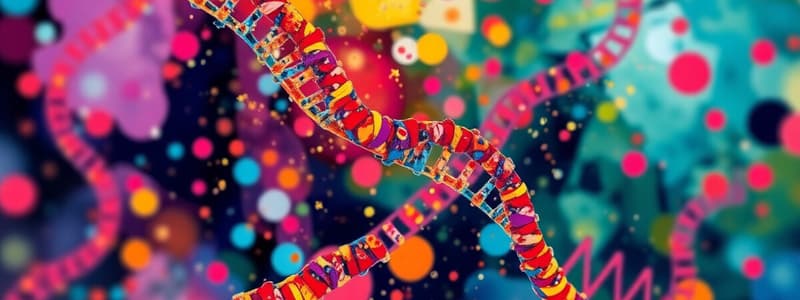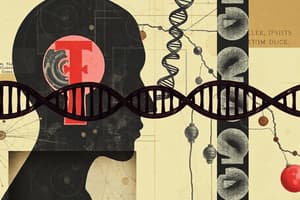Podcast
Questions and Answers
Which characteristic distinguishes a plasmid from a host cell's chromosome?
Which characteristic distinguishes a plasmid from a host cell's chromosome?
- Plasmids are located within the nucleus, while chromosomes are cytoplasmic.
- Plasmids are linear DNA, while chromosomes are circular.
- Plasmids are physically separate from the main chromosomal DNA. (correct)
- Plasmids are composed of RNA, while chromosomes are DNA.
The term 'replicon' is accurately applied to plasmids because they possess the ability to:
The term 'replicon' is accurately applied to plasmids because they possess the ability to:
- Integrate into the host cell's chromosome under stress.
- Initiate and control their own DNA replication. (correct)
- Transfer genetic material between different species of bacteria.
- Undergo transcription and translation within the host cell.
Joshua Lederberg's contribution to plasmid biology is primarily associated with:
Joshua Lederberg's contribution to plasmid biology is primarily associated with:
- Developing restriction enzymes for plasmid manipulation.
- Coining the term 'plasmid' and defining its extra-chromosomal nature. (correct)
- Discovering the first plasmid in _E. coli_.
- Synthesizing plasmids in vitro for gene cloning.
In plasmid construction, restriction enzymes and DNA ligase are essential tools. What are their respective roles?
In plasmid construction, restriction enzymes and DNA ligase are essential tools. What are their respective roles?
Small-sized plasmids typically rely on the host cell's machinery for replication, whereas larger plasmids may:
Small-sized plasmids typically rely on the host cell's machinery for replication, whereas larger plasmids may:
Episomes are a specific type of plasmid characterized by their ability to:
Episomes are a specific type of plasmid characterized by their ability to:
Plasmids are widely utilized as cloning vectors in biotechnology because of their capacity to:
Plasmids are widely utilized as cloning vectors in biotechnology because of their capacity to:
The relationship between a plasmid and its host cell can be described as:
The relationship between a plasmid and its host cell can be described as:
What is the primary function of the origin of replication (ORI) in a plasmid?
What is the primary function of the origin of replication (ORI) in a plasmid?
Which characteristic distinguishes plasmid vectors from naturally occurring plasmids in genetic engineering?
Which characteristic distinguishes plasmid vectors from naturally occurring plasmids in genetic engineering?
In the context of gene cloning, what is the role of a selectable marker gene within a plasmid vector?
In the context of gene cloning, what is the role of a selectable marker gene within a plasmid vector?
What is a 'recombinant plasmid' in the process of genetic modification?
What is a 'recombinant plasmid' in the process of genetic modification?
How do non-integrating plasmids differ from episomes in bacterial cells?
How do non-integrating plasmids differ from episomes in bacterial cells?
In protein production using plasmid vectors, how are bacteria utilized to generate large quantities of a specific protein, such as insulin?
In protein production using plasmid vectors, how are bacteria utilized to generate large quantities of a specific protein, such as insulin?
Virulence plasmids contribute to bacterial pathogenicity primarily by:
Virulence plasmids contribute to bacterial pathogenicity primarily by:
Flashcards
What is a Plasmid?
What is a Plasmid?
A small, circular DNA molecule separate from a host cell's chromosome; replicates independently.
What is a Replicon?
What is a Replicon?
DNA fragment with necessary components allowing it to self-replicate. Plasmids are an example.
Cloning Vector
Cloning Vector
A DNA molecule that carries foreign DNA into a host cell and replicates it.
Plasmid (historical definition)
Plasmid (historical definition)
Signup and view all the flashcards
Restriction Enzymes
Restriction Enzymes
Signup and view all the flashcards
DNA Ligase
DNA Ligase
Signup and view all the flashcards
Episomes
Episomes
Signup and view all the flashcards
Restriction Sites
Restriction Sites
Signup and view all the flashcards
Origin of Replication (ORI)
Origin of Replication (ORI)
Signup and view all the flashcards
Non-Integrating Plasmids
Non-Integrating Plasmids
Signup and view all the flashcards
Plasmid Vectors
Plasmid Vectors
Signup and view all the flashcards
Cloning
Cloning
Signup and view all the flashcards
Recombinant Plasmid
Recombinant Plasmid
Signup and view all the flashcards
Selectable Marker
Selectable Marker
Signup and view all the flashcards
Virulence Plasmid
Virulence Plasmid
Signup and view all the flashcards
Study Notes
- A plasmid is a small, circular DNA molecule separate from a host cell's chromosome, often referred to as extra-chromosomal DNA.
- It replicates independently within a host cell, functioning as a replicon, which is a DNA fragment with replication components.
- Plasmids occur naturally in bacteria, yeasts, archaea, and some eukaryotic cells, forming symbiotic or parasitic relationships with their hosts.
- Plasmids carry genes responsible for specific traits in the host cell, with antibiotic resistance being the most common.
- They replicate prolifically, producing double-stranded fragments, making them useful as cloning vectors.
- A cloning vector is a DNA molecule that transports foreign DNA into a host cell, replicates, and generates numerous copies of itself and the foreign DNA.
History
- Independent DNA strands were discovered in bacterial cells in the late 1940s, but their nature was unclear initially.
- Joshua Lederberg coined the term "plasmid" in 1952, defining it as any extra-chromosomal hereditary element, during a study on Salmonella and virus P22.
- The transfer of bacterial genes by virus P22 to another host was identified, but the phenomenon remained unclear until the establishment of the double-helix DNA structure in 1952.
- Scientists have since discovered more plasmids, which are now heavily used in molecular and biotechnology research.
Plasmid Construction
- Construction involves using restriction enzymes to cut DNA at specific restriction sites.
- The resulting fragments are joined together using DNA ligase.
- Most plasmids are circular, their sizes range from less than 1.0 kilobase to over 250 kilobases.
- Small-sized plasmids utilize the host cell's enzymes for DNA replication.
- Larger plasmids can carry genes that code for replication enzymes.
- Some plasmids, known as episomes (especially in bacteria), insert themselves into the host's chromosome for replication.
- Some plasmids are linear, yet their replication is unique.
Origin of Replication
- Plasmids contain at least one DNA sequence where replication begins, known as the origin of replication (ORI).
- The ORI consists of 50-100 base pairs, enabling plasmid replication.
- Host-cell enzymes must bind to the ORI to start the replication process, common in circular plasmids.
- DNA replication continues around the circular plasmid once initiated, allowing any inserted DNA sequence to be replicated along with the plasmid DNA.
- The origin of replication ensures daughter cells have a copy of the plasmid after division.
- During plasmid replication, integration can be integrating or non-integrating.
- Non-integrating plasmids replicate independently without inserting into the host chromosome.
- Episomes insert themselves into the host chromosomes for replication
Plasmid Vectors
- Plasmid vectors are used in genetics and biotechnology to deliver traits into a host.
- They have a region for inserting a gene of interest, which is then introduced into a bacteria cell for replication.
- Vectors can contain drought-resistance and disease-resistance genes in crops, improving crop yields.
- Engineered plasmid vectors are smaller than naturally occurring plasmids, making them ideal carriers for gene transfer.
- Both plasmid vectors and naturally occurring plasmids are self-replicating, have an origin of replication, and carry unique genes like drug resistance genes.
Cloning
- Cloning involves inserting a gene into a host using a vector.
- The inserted gene is replicated in the host, displaying the desired characteristics.
- Plasmids are used as cloning vectors due to their small size, efficient origin of replication, and cloning limit of 100-10,000 base pairs.
- Some plasmids have multiple cloning sites for DNA insertion.
- Origin of replication, selectable markers, the gene of interest, and multiple cloning sites are used during cloning.
Protein Production
- Plasmid vectors are used to produce large quantities of proteins by inserting a gene responsible for production (e.g., the human insulin gene) into a plasmid vector, introducing it into a bacterium, the bacteria multiply, producing massive amounts of identical bacteria that produce the protein.
Gene Therapy
- Gene therapy involves inserting a healthy gene into human cells to cure or eliminate disease, treating genetic diseases by replacing or repressing defective genes.
- Genes are introduced into patients' cells using a plasmid cloning vector, administered through direct injection or intravenously.
- Gene therapy is used to treat cystic fibrosis, thalassemia, and hemophilia.
Disease Model
- Plasmids are used to generate disease models.
- Rat genetic models were initially created by engineering the embryonic stem cells of rats with plasmids.
- Human disease model creation is now possible by manipulating adeno-associated viruses using plasmids.
Recombinant Plasmid
- A recombinant plasmid results from inserting a gene of interest into a cloning vector, such as a plasmid.
- This plasmid acts as a carrier of the gene of interest to the host cell, leading to the expression of the gene in the host cells.
Selectable Marker
- Selectable markers, ensure that host cells contain the desired plasmid, such as antibiotic resistance genes.
- The vector carries a selectable marker to allow the selection of cells with the plasmid of interest.
- Cells are subjected to selective conditions, ensuring the survival of only those with the plasmid of interest.
- Genes conferring resistance to antibiotics are commonly used in cloning vectors to eliminate non-genetically modified bacteria.
Plasmid Example
- Virulence plasmids can turn a host, such as a bacterium, into a pathogen, making it a disease agent that can spread and replicate easily.
- Escherichia coli, naturally found in the human gut and other animals, can cause severe diarrhea and vomiting due to a virulence plasmid.
- Salmonella enterica also possesses a virulence plasmid.
Studying That Suits You
Use AI to generate personalized quizzes and flashcards to suit your learning preferences.




